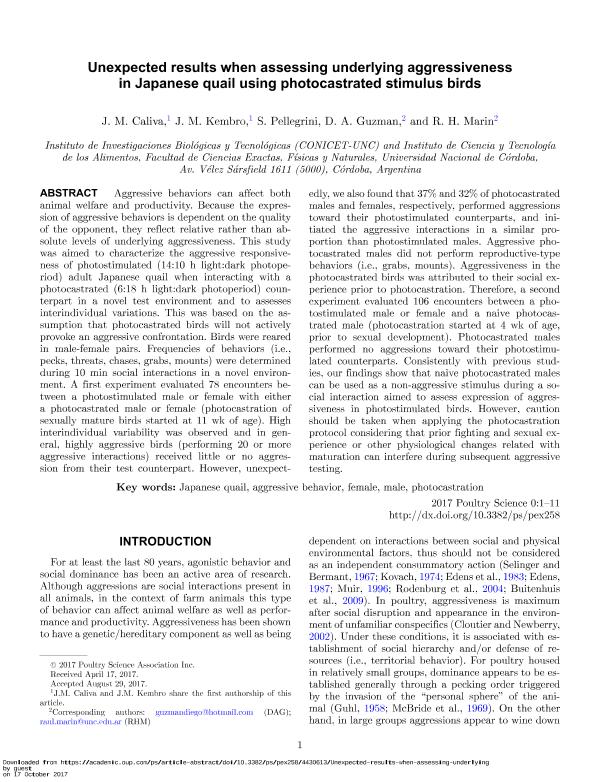Artículo
Unexpected results when assessing underlying aggressiveness in Japanese quail using photocastrated stimulus birds
Caliva, Jorge Martín ; Kembro, Jackelyn Melissa
; Kembro, Jackelyn Melissa ; Pellegrini, Stefanía
; Pellegrini, Stefanía ; Guzmán, Diego Alberto
; Guzmán, Diego Alberto ; Marin, Raul Hector
; Marin, Raul Hector
 ; Kembro, Jackelyn Melissa
; Kembro, Jackelyn Melissa ; Pellegrini, Stefanía
; Pellegrini, Stefanía ; Guzmán, Diego Alberto
; Guzmán, Diego Alberto ; Marin, Raul Hector
; Marin, Raul Hector
Fecha de publicación:
01/12/2017
Editorial:
Poultry Science Assoc Inc
Revista:
Poultry Science
ISSN:
0032-5791
e-ISSN:
1525-3171
Idioma:
Inglés
Tipo de recurso:
Artículo publicado
Clasificación temática:
Resumen
Aggressive behaviors can affect both animal welfare and productivity. Because the expression of aggressive behaviors is dependent on the quality of the opponent, they reflect relative rather than absolute levels of underlying aggressiveness. This study was aimed to characterize the aggressive responsiveness of photostimulated (14:10 h light:dark photoperiod) adult Japanese quail when interacting with a photocastrated (6:18 h light:dark photoperiod) counterpart in a novel test environment and to assesses interindividual variations. This was based on the assumption that photocastrated birds will not actively provoke an aggressive confrontation. Birds were reared in male-female pairs. Frequencies of behaviors (i.e., pecks, threats, chases, grabs, mounts) were determined during 10 min social interactions in a novel environment. A first experiment evaluated 78 encounters between a photostimulated male or female with either a photocastrated male or female (photocastration of sexually mature birds started at 11 wk of age). High interindividual variability was observed and in general, highly aggressive birds (performing 20 or more aggressive interactions) received little or no aggression from their test counterpart. However, unexpectedly, we also found that 37% and 32% of photocastrated males and females, respectively, performed aggressions toward their photostimulated counterparts, and initiated the aggressive interactions in a similar proportion than photostimulated males. Aggressive photocastrated males did not perform reproductive-type behaviors (i.e., grabs, mounts). Aggressiveness in the photocastrated birds was attributed to their social experience prior to photocastration. Therefore, a second experiment evaluated 106 encounters between a photostimulated male or female and a naive photocastrated male (photocastration started at 4 wk of age, prior to sexual development). Photocastrated males performed no aggressions toward their photostimulated counterparts. Consistently with previous studies, our findings show that naive photocastrated males can be used as a non-aggressive stimulus during a social interaction aimed to assess expression of aggressiveness in photostimulated birds. However, caution should be taken when applying the photocastration protocol considering that prior fighting and sexual experience or other physiological changes related with maturation can interfere during subsequent aggressive testing.
Palabras clave:
Japanese Quail
,
Aggressive Behavior
,
Female
,
Male
,
Photocastration
Archivos asociados
Licencia
Identificadores
Colecciones
Articulos(IIBYT)
Articulos de INSTITUTO DE INVESTIGACIONES BIOLOGICAS Y TECNOLOGICAS
Articulos de INSTITUTO DE INVESTIGACIONES BIOLOGICAS Y TECNOLOGICAS
Citación
Caliva, Jorge Martín; Kembro, Jackelyn Melissa; Pellegrini, Stefanía; Guzmán, Diego Alberto; Marin, Raul Hector; Unexpected results when assessing underlying aggressiveness in Japanese quail using photocastrated stimulus birds; Poultry Science Assoc Inc; Poultry Science; 96; 12; 1-12-2017; 4140–4150
Compartir
Altmétricas



